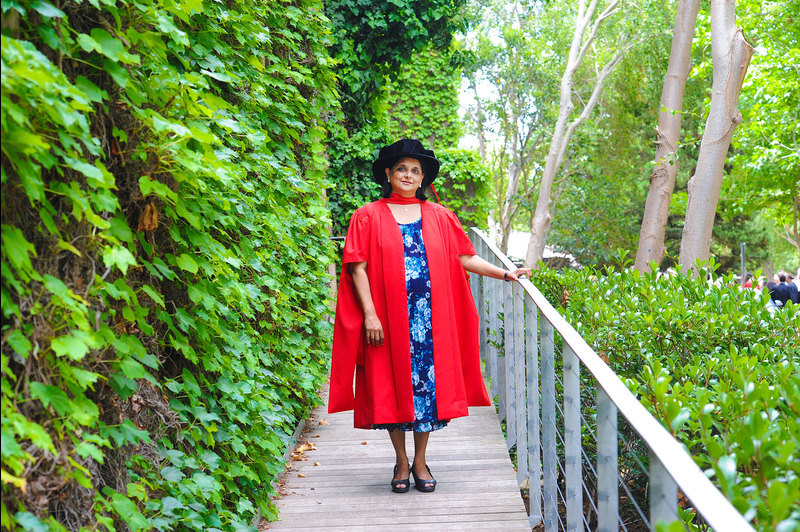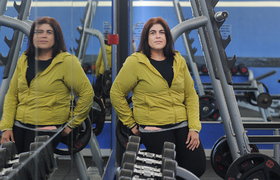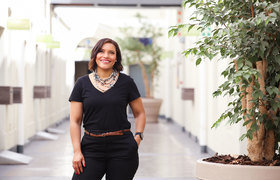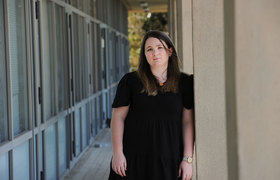Groote Schuur Hospital CEO seeks answers to organisational leadership in PhD
20 December 2022 | Story Kamva Somdyala. Photo Lerato Maduna. Read time 9 min.
Dr Bhavna Patel will celebrate a decade as chief executive officer (CEO) of Groote Schuur Hospital next year and has decided to shine a spotlight – through her PhD thesis – on how a home-grown leadership development programme (LDP) among the executive leaders at the hospital better capacitated their work.
Dr Patel’s passion, leadership and innovation drove the topic of her study, which saw her graduate with a PhD from the University of Cape Town (UCT) on 15 December.
After matriculating from Harold Cressy High School, she enrolled for her tertiary studies at UCT, first towards a BSc, then medicine, followed by master’s degrees in family medicine, public health, and bioethics and health law.
She started working at Groote Schuur Hospital, first as a medical manager, then as the chief of operations. In 2013 she took up the position as CEO. She is the chairperson of the Newborns Trust – an NPO that raises funds for premature, low birth weight and critically ill newborn babies at Groote Schuur Hospital. Dr Patel has also published a book on the history of the hospital.
Kamva Somdyala (KS): Please tell us about your PhD thesis.
Bhavna Patel (BP): My PhD studied the implementation of a home-grown LDP among the executive leaders at Groote Schuur Hospital, specifically analysing whether and how the programme facilitated their capacity as leaders and their continuing work to implement improvement processes across the hospital.
KS: What can you tell us about the hypothesis of the study?
BP: The study proposed a theory of change that through the LDP, there would be behaviour change, resulting in improved leadership of individuals and teams – and by promoting innovation, an improvement in service delivery.
The rationale of the study was that the LDP intended to strengthen the leadership capacity of the 16 executives at Groote Schuur Hospital and how this could contribute to developing a culture of continuous learning and improvement. The executives had to focus on finding innovative ways of dealing with existing problems, and together with their respective teams, contribute to the improvement of delivering quality healthcare to the patients through improved leadership, better team functioning and creating a culture of ongoing continuous improvements.
“The LDP initiative started after I was appointed as CEO of Groote Schuur Hospital in 2013.”
KS: What were some of the challenges encountered during your research? When did you begin and what inspired the choice of study?
BP: The LDP initiative started after I was appointed as CEO of Groote Schuur Hospital in 2013 with a realisation that we needed to learn about our roles and functions as leaders by experiencing our own reality through a lens of the learning being relevant, applicable and practical to the work that we do.
Many courses we attended provided a theoretical background, but we were never able to use the learnings in a realistic setting. Hence, through the home-grown LDP, a programme was conceptualised and developed to encompass learning about the self, learning about developing teams and then also learning about the business aspects of the job.
The programme evolved over time and became part of a new vision of the hospital, where everything that was done as part of the LDP contributed to achieving the vision statement. The development of the tools and a method to conduct improvement processes was also home grown and has to date resulted in many service-related improvements to staff and patient care.
It was only in 2017 that I started thinking about studying this development as part of a PhD and while some of the aspects of the programme were conceptualised by myself, the contribution of the team to its development cannot be ignored.
A huge challenge for me was the role that I had to play as the CEO of the hospital as well as the researcher of the study. Many measures were taken to ensure that the methodology was not compromised in any way. Another challenge in the progress of the study was the appearance of COVID-19, [which] delayed the research for two years.
KS: What is the bigger picture the study seeks to address?
BP: All leaders, but more specifically, leaders of South African public sector hospitals, face a challenge of balancing the huge burden of patient care to be provided within limited available resources. Leaders need to be able to navigate this reality while giving effect to the health and wellness of both the patients and staff.
This study has shown that although leadership development has been implemented in various forms in different hospital settings, none of the existing research reported a combination of leadership and innovation through improvement projects to enhance leader behaviour and team performance at large hospitals in the South African context.
The programme has the potential to serve as a model of organisational learning for other similar hospitals which seek ultimately to serve the needs of the population and become resilient, sustainable, continuously learning, adaptive health facilities that promote improved patient care and satisfied staff.
KS: What did you find most interesting about the study?
BP: The leadership journey that the executive team at Groote Schuur Hospital undertook was not planned, but simply evolved over time and became a series of events that resulted in lots of self-awareness and behaviour change that improved the functioning of the leaders, their teams and ultimately, the services rendered at the hospital.
It is not a standardised process, but one that must be adapted to suit the contextual reality that the leaders face and continue to adapt as the environment changes. Developing leadership is not a finite process, but an ongoing journey of learning.
“I believe that every achievement on a daily basis is a celebration.”
KS: Are you celebrating this milestone? If so, how and why?
BP: I believe that every achievement on a daily basis is a celebration. The hospital executives reflected on their growth as leaders through building relationships, developing themselves through self-awareness and developing multidisciplinary teams. For myself, I think that if anyone gains some value from this study, then that is enough.
KS: What is your opinion of the state of healthcare in the country?
BP: Our country faces a challenge of high unemployment, poor socio-economic circumstances and a health burden that the current public services cannot support. Specifically challenging is the alarming increase in patients with chronic illnesses, psychiatric symptoms, cancers and injuries related to trauma and violence.
What we are currently doing is merely being responsive to what enters our doors, but to improve the state of healthcare in our country, we will need a more proactive rethink of how services are being provided within the larger system. This requires a whole of government and a whole of society approach to healthcare.
Whether the National Health Insurance is the answer to this remains to be seen, but this too can only work if supported by sufficient leadership, education, staffing skills, appropriate infrastructure and an appropriate budget to meet the needs.
KS: What has your experience of being CEO of the hospital been like? What are some of the challenges you face?
BP: Having come out of COVID-19 earlier this year, healthcare is trying to address what was lost, but at the same time facing significant pressures of very ill patients entering our emergency and psychiatric services. Additionally, the focus on staff wellness has become a priority, but the staff are generally tired and achieving a balance is not easy. On top of that, the budgetary challenges also hamper our ability to progress. However, our leadership learnings have taught us to continue to adapt and do what we can with the resources we have. We remain proudly Groote Schuur Hospital.
 This work is licensed under a Creative Commons Attribution-NoDerivatives 4.0 International License.
This work is licensed under a Creative Commons Attribution-NoDerivatives 4.0 International License.
Please view the republishing articles page for more information.










